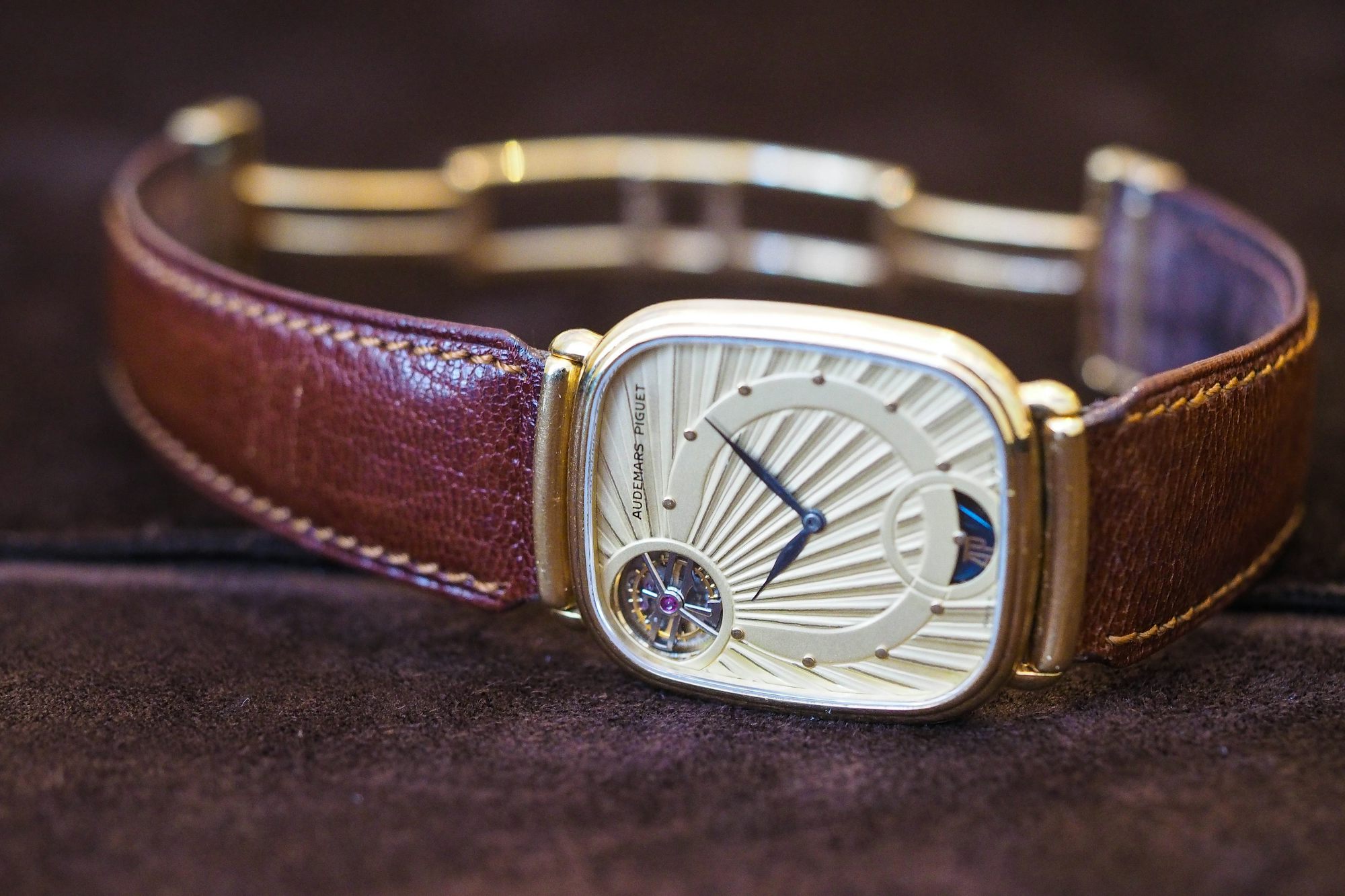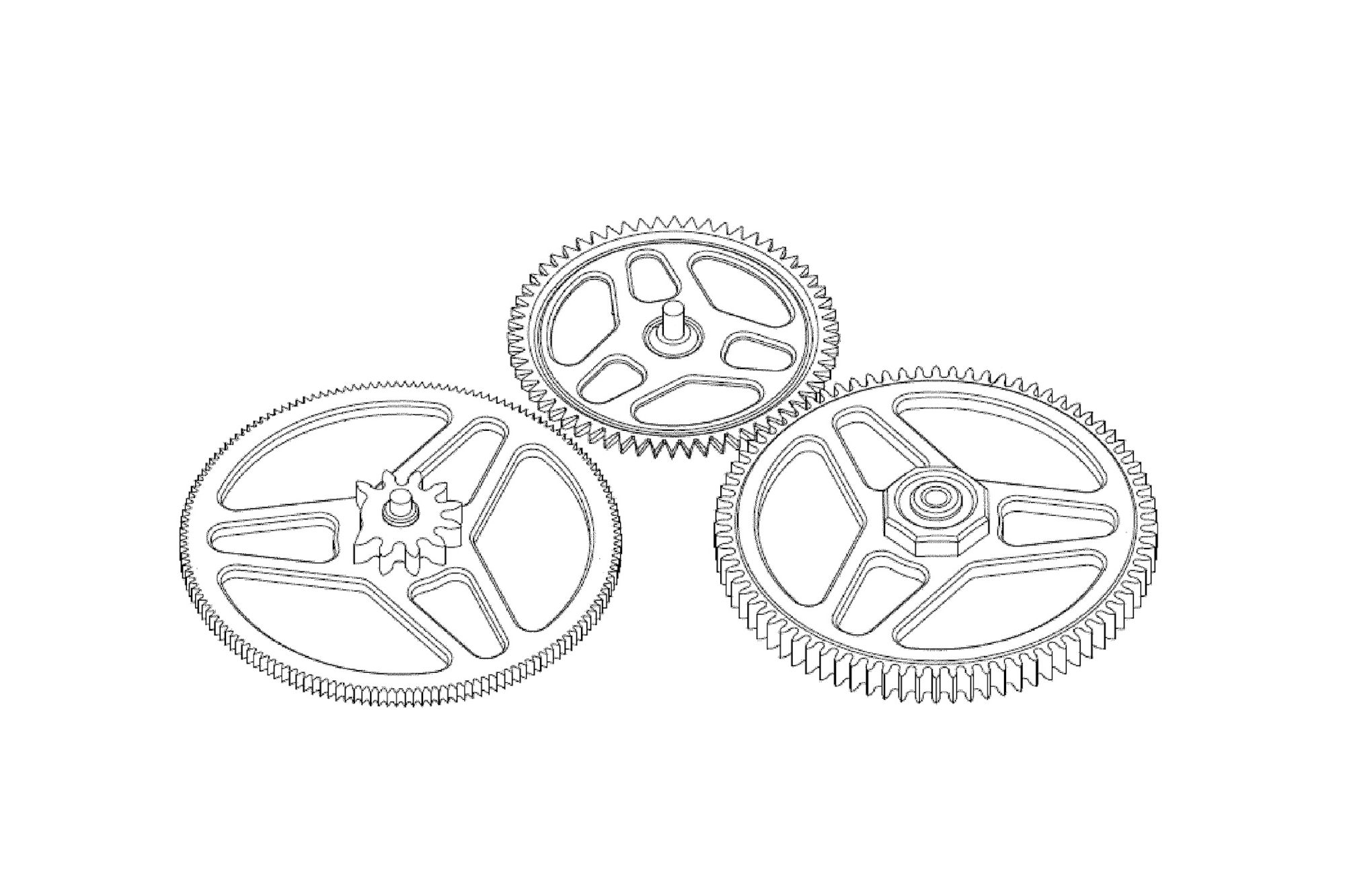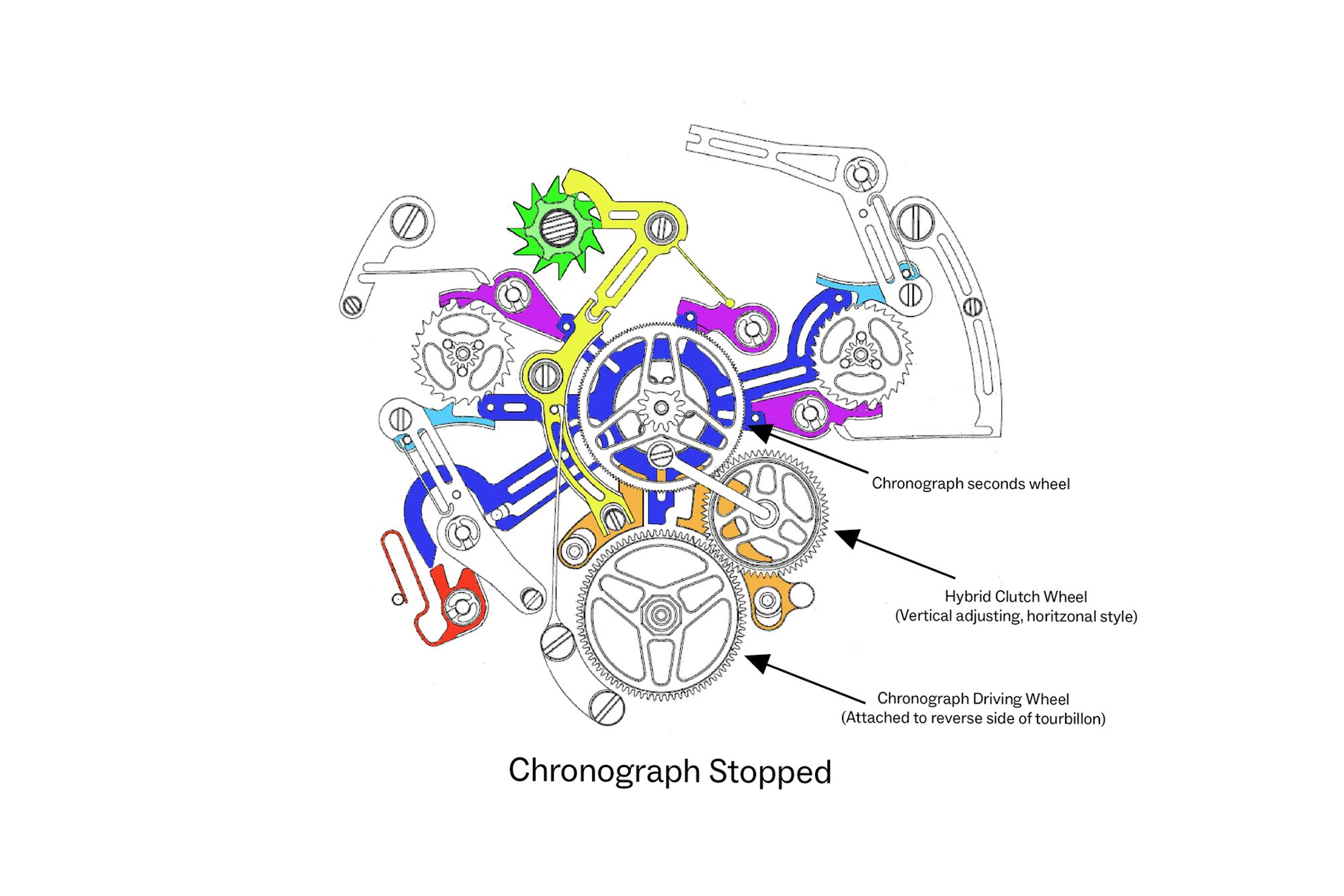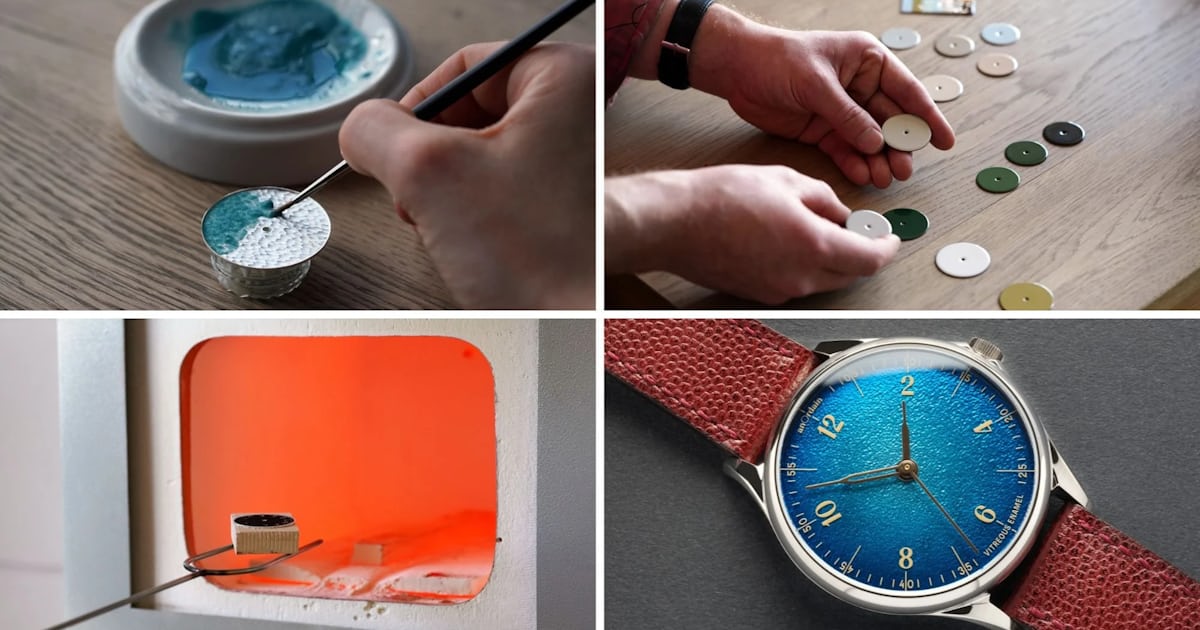Editor’s pick — Accessory quick take: key highlight (movement/specs for watches, materials/finish, limited run, pricing tier) in 1–2 lines.

Two things come to mind when I think of modern Audemars Piguet. First is the Royal Oak, which has become such a cornerstone of the brand that it has also become an easy vector for feedback, which is unfortunate because the “Jumbo” (not the largest, just the one that measures 39mm by 8.1mm, close to the original size) is, in my humble opinion, the best-wearing watch on the market. The second is the brand’s industrial engineering and micromechanics capabilities at its Le Locle factory, which evolved from Renaud & Papi (APRP). With Lucas Raggi as Chief Industrial Officer and Giulio Papi (who heads watch conception), AP is making remarkably wearable, highly technical products.
I shouldn’t have been surprised—and yet I was—that the Royal Oak Extra-Thin Selfwinding Flying Tourbillon Chronograph RD#5 (reference 26545XT), the last of the brand’s Research and Development series, seems nearly as impressive as the previous. That’s saying something, as the RD#4 “Universelle” is one of the most complicated, yet somehow wearable, watches in the world.

The Royal Oak Extra-Thin Selfwinding Flying Tourbillon Chronograph RD#5.
The combination of a tourbillon and a chronograph (with jumping counters) presents technical challenges, not least for a brand that rarely made tourbillons in the 20th century. In fact, before 1986, only four watches in Audemars Piguet’s catalog had a tourbillon.
In that way, it’s probably the least “Audemars Piguet” complication (which, for the sake of ease of conversation, we will call it a complication) in their history. Then, in 1986, AP introduced the world’s first self-winding tourbillon, the ref. 25643, complete with an unusual sunray motif, a tiny tourbillon, and ultra-thin dimensions, was groundbreaking. Yet, as it had no historical basis and no true successor, it never felt emblematic of the brand.

The Sun-Ray tourbillon ref. 25643.
Other tourbillon releases would follow, including the ref. 25831ST, with a 12 o’clock time display and a very condensed, quasi-octagonal frame around the tourbillon on the dial. I would argue that it wasn’t until the last half-decade or so that Audemars Piguet finally integrated the regulating organ into the Royal Oak in a cohesive way with the introduction of the ref. 26530 Royal Oak Selfwinding Flying Tourbillon. The tourbillon felt like a cohesive part of the greater design, eschewing the bridges that (previously connected to the dial) distracted from the strong visual lines of the Royal Oak.

The split-second mechanism inside the ball-bearing of the rotor for the Royal Oak Concept Split Second Chronograph GMT Large Date.
Chronographs, at least in wristwatch form, have never been the heart of Audemars Piguet’s identity. There is far more history with the brand making chronograph pocket watches. Yes, there are some outstanding chronograph wristwatches from AP—both in aesthetics and technicality—but these achievements have been mainly eclipsed in the vintage market by Patek’s success (and prolific nature) with the complication.
Then there’s AP’s claim as kings of the perpetual calendar, which stands out far more than anything else. Yet, with recent innovations like a new split-second mechanism from the RD#4, which places it inside the winding rotor’s ball-bearing, and the new RD#5, AP is asserting itself on the chronograph stage.
The Technical
In some ways, a “Jumbo” is a “Jumbo” is a “Jumbo.” Thirty-nine millimeters in diameter. Eight-point-one millimeters thick. Octagonal case. Industrial-inspired aesthetics. We’ll eventually get to the wearing experience and how this “Jumbo” is a different experience on the wrist. But as an “RD” (Research and Development) watch—heck, as the last RD watch— it makes sense to start with the technical aspects that make this watch so impressive.
The tourbillon arguably takes a back seat to the chronograph here. As previously mentioned, the 2020 launch of a Self-winding Flying Tourbillon, followed by a skeletonized version in 2022, and, more specifically, the 39mm “Jumbo” RD#3 in 2022 (which was downsized to 37mm that same year) was a jumping-off point for this release. The RD#3 was impressive to collectors and people with a technical understanding of watchmaking as the first “Jumbo” to feature a tourbillon. In fact, I think many people at the time would have told you that was about as far as AP could take it.

The Royal Oak Selfwinding Flying Tourbillon Openworked, released in 2024.

The original RD#3, which was the first tourbillon fitted into a “Jumbo” case size.

A subsequent 37mm RD#3 from 2024.
The movement measures 31.4mm by 4mm, and is remarkably thin, only 0.6mm thicker than the RD#3, which lacks a chronograph. It also boasts a 72-hour power reserve versus the 50 hours of the RD#3, which is no surprise when you use the mainspring barrel hidden on the dial side of the watch below. Actually, from the front, the watch looks relatively understated, with the keyless works at 3 o’clock, the winding and click at 1 o’clock, etc. The tourbillon’s peripheral gearing appears to run directly to the rest of the going train, with little else.

Photo courtesy Audemars Piguet.
From the rear, the architecture is unlike anything I’ve seen before. Bridges are floating, seemingly connected to nothing. Springs cross open spaces. Openworked levers ostensibly activate and run the chronograph, but it’s hard to tell how. The movement is peripherally wound, and you can see the gearing at 1 o’clock and 3 o’clock (on the rear view), which transmits this movement to the rear side to wind the mainspring. The rest of the movement looks high-end, but somewhat alien. Blasted and vertically brushed surfaces add to the futuristic technical design.

Photo courtesy Audemars Piguet.
To understand what’s going on here, I turned to European Patent Filing EP4555385A1, filed on July 13, 2023, by Manufacture d’Horlogerie Audemars Piguet SA, with Julien Martel and Guilio Papi listed as the inventors. There are some minor differences in design and technical application from the patent, but it serves as a good guide (albeit it took me some time to understand it in French, or even in translated English). If anything is wrong in this explanation, I take full blame, since I didn’t ask AP for a briefing. The illustrated rear view is below.

The rear view of the AP RD#5, from European Patent Filing EP4555385A1.
Clear? Well, probably not quite. So I spent a few days manually parsing the other diagrams, stripping away the numbers, coloring, and then animating the meaningful parts of the chronograph works to illustrate how AP created one of the thinnest chronographs in the world (and did so with a tourbillon). As suggested by the patent application, a number of the solutions are ingeniously novel. Let’s start with the basic start-stop-reset function.
Rather than using a straightforward vertical or horizontal clutch system, the RD#5 uses an unusual hybrid. Each system is relatively self-explanatory, though we’ll focus on the horizontal. A horizontal clutch features an intermediate wheel that, when a push-piece is pressed, causes a lever to move the intermediate wheel into place, connecting the going train to the chronograph wheel, which starts the timing. There are downsides, however, including friction and grinding during coupling.
After pressing start or stop, the column wheel (in green, below) rotates, moving linkages (yellow) into an engaged or disengaged state. That linkage is connected to a large lever (in orange) which, in either stopped or reset position, keeps the hybrid clutch wheel up on its pivot point and disengaged from the chronograph seconds wheel. When the chronograph is started, the linkage pushes the yellow lever, which slides out of position and allows the clutch wheel (which maintains constant connection to the gearing on the reverse side of the tourbillon), to lower into a position connected to the chronograph seconds wheel.

Illustration from European Patent Filing EP4555385A1. Animation and coloring by Mark Kauzlarich.

The set of gears goes from the tourbillon (right) to the intermediate horizontal clutch wheel to the chronograph wheel (with the unusual retrograde gearing above). Illustration from European Patent Filing EP4555385A1
The system takes up less horizontal space, helping reduce the movement’s diameter. But the design goes further. To minimize wear and impact during meshing of the going train to the chronograph wheel, the hybrid clutch features a beveled edge on the underside of the gear teeth, allowing it to slide into place more easily.
The gear on the reverse of the tourbillon is noticeably taller, allowing the clutch wheel to remain engaged during its vertical action. There’s also a small metal “tongue” connecting the central bridge to the clutch wheel to prevent excessive play in the clutch that could cause it to disconnect. The system can be seen in my own photos below, which I’ve turned into a GIF.

The RD#5’s hybrid horizontal clutch. While it moves vertically, it operates more aligned with the principles of a horizontal clutch mechanism. Photographs and GIF illustration by Mark Kauzlarich
More ingenious but more difficult to explain or understand are the reset mechanism and the instantaneous jumping minute and hour counters. The GIF above removes this mechanism for ease of illustration. Below, you can somewhat see (under the central bridge system) that there is a series of swinging arms connected to the chronograph wheel, minute, and hour counters via an unusual gearing (with two teeth removed and one shortened). You can see that specific system in the next diagram.


You can see the spring arms that press against the counterweighted racks, forcing them back to their reset position when able. Illustration from European Patent Filing EP4555385A1.
The diagram below is specific to the chronograph seconds wheel, but the principles are similar for the counters. As the chronograph seconds wheel turns, another pinion gear with 10 teeth (two removed from the original 12 and one shaved down, as shown in magenta) imparts that rotation clockwise to a seconds rack. Shown above is the full set of arms, with three small metal return springs, pushing on a part attached to the arm at the rack’s center post.
The two forces—spring and rack—are constantly fighting each other as the rack advances. As the arm reaches the end of the gearing and the chronograph wheel crosses back to 0:00, the geared rack slides off the last pinion tooth. Disconnected from the “push” of the mainspring, the return spring forces the rack back; it flies back along the flat section between the two missing teeth and hits the break at the end of the rack. It then won’t start moving again until 5 seconds into the chronograph rotation, when the teeth engage again.

Illustration from European Patent Filing EP4555385A1. Edit and coloring by Mark Kauzlarich.
The entire time, the rack turns at the P1 pivot point (as shown in the illustration), while a linkage attached to the P2 pivot point moves forward and back with the rack’s rotation. At the opposite end of the linkage is the minutes advance pawl (shown in light blue), which is drawn back over the minute counter advance wheel, into place, and then instantly pushed forward as the rack swings back, creating that instantaneous jumping counter.

Illustration from European Patent Filing EP4555385A1. Animation and coloring by Mark Kauzlarich.
At the same time, the system steps down using similar principles, subdividing the minute counter’s jumps into small gear movements that are transmitted to other pinions and racks, connected to yet another, more complicated linkage. You can see this linkage (above in grey) in photos of the movement, where it runs around the lower edge of the rear of the tourbillon. The system here is the same: a rack with a flat spot interacts with a pinion attached to the minute counter (with 30 gears), slowly moves the rack and therefore the linkage until it fully pushes the opposite pawl, advancing the hour counter wheel by half an hour (since it has 24 teeth on a 12-hour counter).

The system is under constant tension between the racks and return springs. When the chronograph is stopped, the brakes for each advance pawl (shown in purple on both diagrams) move into place so that even though the system isn’t pushing the rack continuously forward, the return spring system doesn’t automatically reset all counters. However, when the lower pusher is activated, it pushes down a spring-loaded block (in red), allowing the carrier reset system (in blue above, which underlies all this and is attached to all three brakes and levers) to shift counter-clockwise. This lifts (and therefore releases) the light blue advance pawl and the purple brakes, regardless of whether the chronograph is running, resetting the system. That enables the flyback function, which restarts the chronograph and resumes counting when the pusher is released (and the spring of the blocker moves back to neutral, pushing the carrier lever out).
Obviously, the gear train (pushed by the mainspring) needs to transmit more force than the return springs are resisting, but not so much that it affects function. It’s a delicate balance of tension. The return springs also act as shock absorbers for the chronograph and counter jump, so that there’s no stutter when the system advances. In practice, the watch worked flawlessly as I activated, reset, and used the flyback function dozens of times while watching the movement to understand it and confirm that there truly was no stutter.
The Hands-On
Hundreds of thousands of words have been written about the design and history of the Royal Oak. As a watershed moment in design. As a pop culture object. And as a hype piece. As Karl Lagerfeld said, “a fetish object.” As a platform for complications with the ref. 5554, 25554, RD#3, and other watches. To me, a Royal Oak is at its best in its original “Jumbo” dimensions—39mm by 8.1mm—and yet this is both the ultimate “Jumbo” Royal Oak, and probably the most unusual one ever made.

The first thing that you notice when wearing the RD#5 is that the feeling is the same: perfect. Truly. It’s not just history that makes me love the “Jumbo” case profile so much (though that helps). Even as a larger guy with a larger wrist, the 39mm by 8.1mm size (with approximately 49mm length) sits so perfectly on my 7.25″ wrist and maintains a thin, unobtrusive profile. It wears almost like a cuff, which is even more true given the ultra-light titanium case (with palladium 500 bulk metallic glass intermediary links and bezel). That’s the same case material used in the 16202XT released in 2023, yet I don’t remember being so struck by the lightness. Maybe it’s because the dial design makes it apparent that you’re not wearing a time-only watch.

The case profile almost looks thinner than 8.1mm, maybe emphasized by the interesting, rounded rectangular pushers. They’re so unobtrusive that when John Mayer “leaked” or “teased” the watch with his “prototype car wrap” laser-etched model (if you know, you know), no one noticed he was wearing a chronograph. While the pushers barely stick out from the case enough to be seen, they’ve got enough travel to feel satisfying when activated. The crown features its own pusher that changes the crown’s function from winding (in) and setting (out), with a red ring displayed around the button.



The design touches are the obvious second thing that would catch a wearer’s eye, and maybe the most divisive part (aside from the price). Despite their status as an icon, Royal Oaks have plenty of detractors. Even putting that aside, it’s certain design elements that make this the least “Jumbo” a Jumbo has ever felt.
The 150th-anniversary script text is probably the first place some collectors might take exception. The dial features the quintessential PVD-coated Bleu Nuit, Nuage 50 petite tapisserie dial with “bathtub”-style hour markers overlapping an exterior track, with each second subdivided into three parts for the 3Hz movement (and therefore chronograph). These touches are comfortably traditional, but the historic script logo feels a bit at odds with the rest of the watch’s brutalist aesthetic. I liked that touch, especially on the “farewell” openworked perpetual calendar, but here it feels a bit dainty.

The flying tourbillon cage is much more at home on the 26545XT, partly because Audemars Piguet has been making tourbillon Royal Oaks for over 25 years (the first was the 25th-anniversary 25831ST). More recently, the melding of a flying tourbillon with the Jumbo case and a traditional blue dial in the 26670ST (for the brand’s 50th anniversary) set the stage well enough that I feel comfortable with the idea of an RO tourbillon.

But what surprised me was how much my brain struggled to grapple with the idea of chronograph counters on something that could have otherwise been mistaken for a time-only watch. There was something in the photos that made the dial’s balance feel constantly in tension, but I reserved judgment until I saw it in person.
It immediately struck me that the snailed counter subdials changed the dial balance completely, especially with their placement slightly above the center line. It’s similar to the tension created by the Datograph subdials placed below the line between 9 and 3 o’clock. Tension, however, isn’t a bad thing. It’s the kind of pull that pulls your eye over and over.

As I mentioned, the sizing feels perfect. The ultra-light material itself is comfortable, but prompts the brand to return to an interesting bracelet construction. While you still have the push button for the butterfly clasp, titanium Royal Oak bracelets (like the 15202IP in titanium and platinum) require a screw in the back of the main link when using a center intermediate link of a different material. Credit goes to our friend Eric Ku for pointing this out in the comments of our introductory story.



The case finishing is great, with the vertically brushed titanium and high-polished chamfers holding texture and color exactly as well as (and nearly indistinguishable from) a Royal Oak in steel. The bezel, intermediary links, and caseback are in palladium 500 bulk metallic glass. When you cool metal quickly enough, you get a non-crystalline amorphous internal structure that is actually, by definition, a glass – a glass with incredible hardness and shine. That’s great for the normally scratch-prone bezel, but it’s not scratch-proof. It’s also incredibly shiny—far more so than any steel or gold Royal Oak —and, more often than not, turns into a black ring reflecting a shadowy room. It’s strangely distracting and not my favorite effect, but I have to admit that, as a material, it’s probably preferable.



I’m a fan of the movement treatment on the new RD#5. Outside their openworked movements, Audemars Piguet’s finishing has never been the draw, at least not in the traditional sense. It’s possible that Chopard has long since taken the crown as the best larger-scale manufacturer with the best traditional finishing.
But AP hits the nail on the head with the futuristic styling of the RD#5 movement. The darker blasted base plates add contrast. The lighter, straight-grained bridges almost look like an alien mouth full of teeth opening from the center, or a futuristic spaceship. If AP had created a movement this technical and treated it like a Lange, it would have been confusing. This, however, perfectly melds the technical micromechanics with finishing.



The Royal Oak Extra-Thin Selfwinding Flying Tourbillon Chronograph RD#5 is limited to 150 pieces. I do not doubt that AP will sell through all pieces without much headache; however, the CHF 260,000 price tag may be a hang-up. I’ve heard from several collectors (ones who would be on this 150-person short list) that the figure has caused some pause and consideration before buying, which suggests that AP has maybe pushed the outer limits of what a Royal Oak can be, not just technically but economically. That said, for those who can afford it, there shouldn’t be much second-guessing. The RD#5 is undoubtedly one of the most impressive watches of this year and one of the most important watches in the brand’s history.

For more information on the Audemars Piguet Royal Oak RD#5, visit the brand’s website.
Source: www.hodinkee.com — original article published 2025-10-30 17:00:00.
Read the full story on www.hodinkee.com → [source_url]



